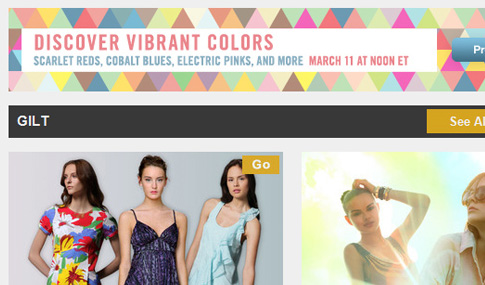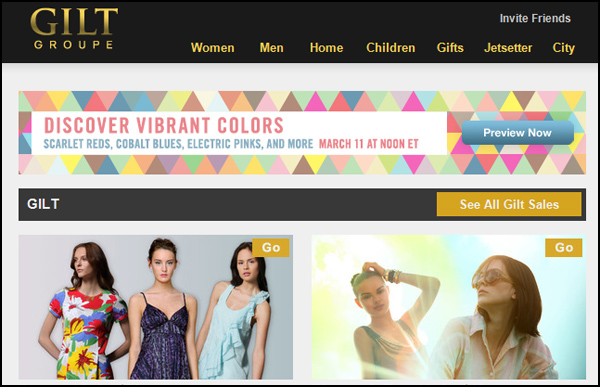
I was very fortunate to attend a keynote speech by Kevin Ryan, the CEO of Gilt Groupe at WWD MAGIC last month. If you pay even the slightest attention to what’s happening in e-commerce, you have heard of Gilt Groupe. If you are consumer in today’s digital world, you’ve heard of Gilt Groupe. If you live under a rock, you’ve heard of Gilt Groupe.
Now that we established that you’ve heard of them, here is a little background. Gilt started out launching flash sales in the women’s apparel realm with a few employees, and has since branched out to include men’s wear, accessories, home, and travel and is currently moving five football fields of merchandise daily with the help of six hundred employees. They have around 100,000 people waiting for the noon sales to start each day. That’s pretty impressive.
Why are brands participating? Gilt has positioned itself as a hybrid of a store and the media. As a brand you want to reach hundreds of thousands of people, right? Well Gilt can do this for you and it’s not just people they are reaching but people who are obsessed with fashion; people whose friends come to them when they want to know what to wear and what to buy. If you really think about it, labels are not truly committing the time and energy to creating an amazing shopping experience, are they? They can’t. And it’s for no other reason than they don’t have 600 people focused on creating the best possible shopping experience available.
And it’s not just through flash sales anymore, either. Consider this; Brooks Brothers actually launched its full price collection through Gilt, showing that the platform does not need to only be utilized at the end of the cycle when brands are trying to move overstocked inventory. Brands can access, at an early stage, Gilt’s passionate followers who all equate its site with luxury.
The majority of this keynote was about digital trends and the importance of properly implementing them into your venture. Kevin Ryan made some excellent points and shared real-life ways of execution.
Digital Trends and Fundamentals of E-Commerce:
Online spending– More money is being spent online than ever before; never underestimate what people will buy online while in the comfort of their own homes.
Social Media– are you creating a place for people to interact? If so, are you doing a much better job at it than everyone else? Keep in mind that the number of followers you have doesn’t matter as much you may think. What does matter is how many people are visiting and engaging on your page.
Mobile, Mobile, Mobile– 10% of Gilt’s revenue is coming from mobile. The site actually sold a $24,000 non-returnable watch on an iPad; showing that it’s amazing what people will buy electronically. The idea of purchasing something online that costs more than some people make in a year, but not seeing or holding it in person, is remarkable.
Some other things to consider in the mobile area: People with money to spend are often sitting in conference meetings, attending keynotes, and getting lost in other large audience situations and feeling a little, shall we say, bored. They can (and have been) shopping when they are supposed to be listening. No judgment here, just an interesting thing to remember when considering how important your mobile app actually is to your company.
Additionally, a lot of companies actually ban their employees from going on ecommerce sites during the work day. This however, does not keep said employees from online purchasing on a Tuesday at 3:30pm. Instead, they pull out their mobile phones or tablets and click through to purchase.
Flash Sales- increasingly popular and something consumers are starting to expect; whether your site is exclusively made up of this style of shopping or it’s simply an aspect of what you do.
Personalization– probably one of the most important aspects of online shopping; second only to technology, personalizing the shopping experience is key. How do you do this? By creating clusters, adjusting your email to the interests of each particular consumer based on the views and clicks (Gilt currently sends out 2,000 versions of theirs), and even by going as far as to create a landing page or home page that is customized to the consumer’s interests.
One example is Gilt’s ability to offer a customer a sale on a Thursday that originally ran on Monday. If the merchandise was not sold out on Monday, and Gilt notices that consumers who generally purchase items in that category did not log in on Monday, then they show that same sale to them on Thursday. Another example is weather targeting, making sure you’re not sending winter coat sales to people in Miami.
Additionally, Gilt’s top 4,000 customers spent $50,000 last year on the site and the company goes out of its way to give these top buyers great service and special incentives. They will see something different than other consumers when visiting their homepages and emails; additional tabs, special deals, wine tasting invitations, etc.
The site also personalizes the experience for the brands they sell. A men’s suiting brand may say- I don’t think I want to offer such an amazing sale to such a large scope of people; we can’t afford to do that. So Gilt says- ok, how about we show your sale to 25,000 men who purchased a thousand dollars worth of suiting from your competitors, not just clothes, but suiting. Excellent.
Technology– this is how you achieve all the personalization that goes into an amazing shopping experience. Hiring the CTO should be the first thing a new venture does. Pay for quality because unbelievable technology is absolutely key.
Here are some other facts and words of wisdom from a man who clearly knows what he’s talking about:
- Facebook is amazing- They are estimating 2 billion in profits this year and will probably be the first trillion dollar company in the U.S.
- If you can’t complete your online objective in 2 to 5 minutes, you’ve just found a business opportunity
- When analyzing your email marketing reach, keep in mind that a lot of your best customers will be turning off email because they access the site everyday through Facebook, RSS feeds, and twitter.
- The early bird gets the worm but it’s the second mouse that gets the cheese. It’s all about execution; do a better job than the first one on the scene and success will be yours.
This keynote was one of the most informative and impressive I’ve ever been to. What I leaned most is that at the end of the day, execution is the most important aspect of building a business. You will always have competitors but the key lies in doing a better job. You must move quickly, take some risks, understand the core trends, and get great people.


1 Comment
Comments are closed.